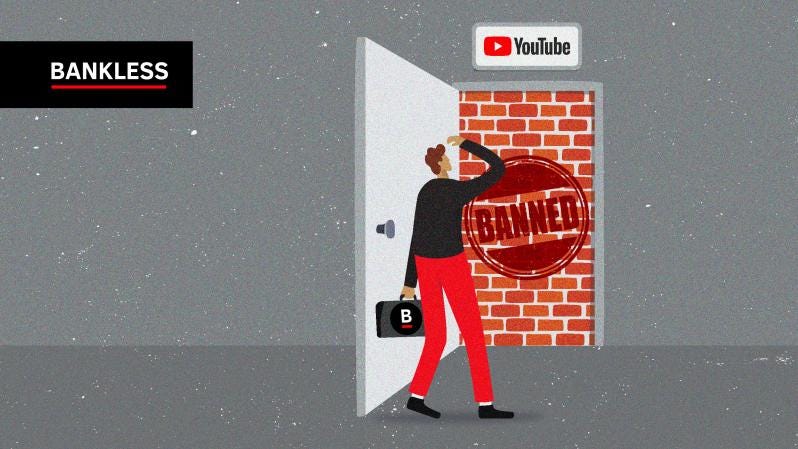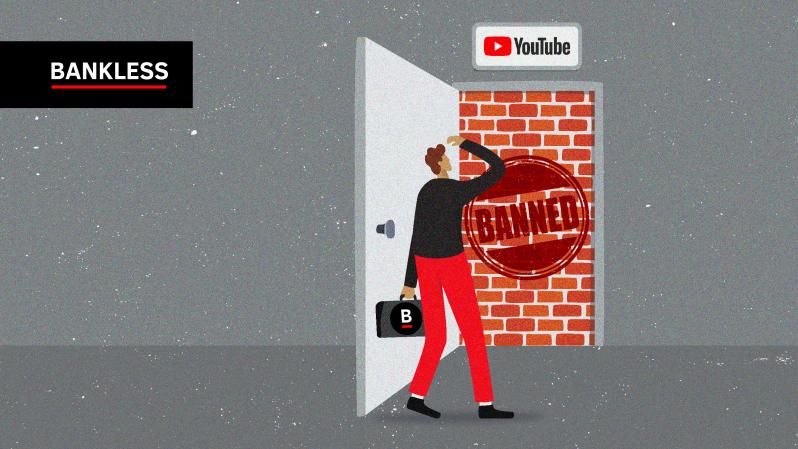Bankless BANNED from Youtube

Dear Bankless Nation,
Late Sunday night, the Bankless Youtube channel got banned.
Over 10,000+ hours of content instantly gone. 😱
We scoured our channels for a reason from YouTube—there were none.
They can ban us anytime, for any reason, without notice. 😱
So we tweeted and asked you to help.
The crypto community rallied behind us as thousands of retweets flooded in. (Thank you Bankless Nation!!) 🏴
Later that day YouTube unbanned the channel. We got their attention.
The following day the CEO of YouTube publicly apologized! 🤯
(Btw she seems cool. Should we have her on the pod?)
We’re grateful for the quick reversal. But the fact that this can happen is the real problem.
The issue was promptly fixed only because our community had a voice.
For the vast majority of independent video creators on YouTube who fall under the shadows of arbitrary banning, that’s a luxury they don’t have.
Filing appeals through the official channels can take weeks or months on end.
We need censorship-resistant, credibly neutral social platforms built for the people.
We need web3 social.
Donovan dives into this in detail today.
- RSA
P.S. What’s going on with LUNA & UST?? 😱 Subscribe to our YouTube now to get notified as soon as our UST episode drops. Full post-mortem tomorrow on the newsletter.
Why we need web3 social platforms

Is there a Big Tech censorship bias?
A hot topic in contemporary politics over recent years is censorship/moderation bias on Big Tech platforms.
For years, the political Right has complained incessantly of Silicon Valley’s alleged political bias. Their grievances of Big Tech’s bias culminated in Twitter’s Trump ban during the 2020 presidential elections (Trump sued and the lawsuit got thrown out of court this week).
It’s a plausible narrative held together by anecdotal evidence.
Yet it’s also true that many on the right enjoy a prominent presence across all major social media platforms.
In the months leading up to the 2020 Election Day, Trump dominated Biden on Facebook engagement at a 87% to 13% ratio. Brad Parscale, Trump’s social media director stated plainly that “Facebook and Twitter were the reason we won [the 2016 elections]”
In 2019, all partisan right-wing YouTube channels (e.g. Fox News, Daily Wire), received 662 million in “hours watched”, slightly higher than the 659 million hours that partisan left-wing channels (e.g. CNN, MSNBC) racked up.
Even Google has been accused of skewing search results in a way that favors liberal results though these claims have been challenged by The Economist and Stanford research.
And Republicans aren’t alone in thinking Big Tech hates them. The Left too has expressed the belief that Big Tech unfairly persecutes their side. The outcry against Elon Musk’s recent purchase of twitter by the Left may have more to do with fears that twitter’s censorship policy may move against them.
Vitalik put it this way:
Depending on which side of the political aisle you call home, there’s a different media narrative around Big Tech censorship for you to embrace.
It’s easy to ply the “Web2 bad, Web3 good” narrative here and throw the blame at the feet of Big Tech content moderators. But the reality is that when you moderate millions of hours of content, you have to rely on algorithms.
When you rely on algorithms, inconsistencies and mistakes are bound to happen. Pleasing everyone is impossible.
The algorithms become the censors.
Codified language in official “content moderation policies” cannot possibly ex-ante anticipate all wrongdoings. The language is vague, so Big Tech moderators have leeway to interpret what counts as a transgression in the context of an ever-changing cultural landscape where gender, racial, and linguistic norms that were considered okay ten years ago would be considered in bad taste today.
It’s why traditional newsrooms have editorial discretion to decide what to include or exclude and also why legal scholars continue to debate the true meaning of the American constitution after it was written two and a half centuries later.
The perils of centralization
This is less about who Big Tech may or may not be biased against. That will change with different owners and regimes. The more interesting question is “Why is there so much disputed debate and uncertainty over bias?”
It’s hard to deny that the reasons surrounding social media regulation are often seemingly arbitrary and opaque. Big Tech companies are, after all, centralized. Their inner workings aren’t transparent because their algorithms are intellectual property worth billions.
Asking them to make their algorithms public is akin to asking Coca-Cola to unveil the recipe of its iconic soft drink.
But at the root of the debate around censorship bias lies the lack of credible neutrality, a concept that Vitalik has often brought up in the context of Web3.
Credible neutrality can be simply summed up as such: Whatever decision is reached, its decision-making (and the rules that govern that process) should be created as transparently and equitably, and non-discriminatory as possible.
In legal philosophy, this is known as the rule of law. It’s a meta-legal doctrine that first-world courts of law adhere to. It’s what distinguishes dictatorships and the free world. Rule of law empowers people with a sufficiently wide (but not maximalist) scope of freedom so they can pursue their lives without being subject to the arbitrary whims of another man’s will.
Fair rules/laws are non-discriminatory and crafted in ignorance of application to any specific citizen, or business industry. In contrast, laws are unfair when they seek to single out persons and outlaw specific behaviors/traits. Common examples of such laws include those that punish the higher-income (progressive taxes), that discriminate against minorities (slavery, apartheid), or laws that favor specific industries (protectionist tariffs).
Big Tech’s content moderation algorithms may not necessarily suffer from a calculated political bias, but the problem is that its decision-making (the laws) isn’t transparent. That’s why it breeds so much discontent on all sides of the political spectrum—it lacks “rule of law”.
When punishment is meted out, the rules are unclear. We don’t know why or how those conclusions are reached. Cue the game of whataboutism.
As a result, social media users, entrepreneurs, and companies like Bankless, are subject to the erratic pendulum of Big Tech’s arbitrary content moderation, swinging in random directions at the whim of any given moment, penalizing some and favoring others.
Blockchains provide a solution to centralized social media
Arbitrary censorship in Big Tech stresses the importance of using peer-to-peer systems technology to decentralize our content streams.
Blockchains provide that first step towards addressing the power imbalance in the current social media landscape, and establishing credible neutrality. It’s a public ledger in which laws (smart contracts) are publicly accessible and certain. In short, it imbues the rule of law into the digital commons.
Just as blockchains are decentralizing financial ownership, they are also providing a valuable pathway to decentralizing ownership over social capital—our reputation and connections online. It’s an opportunity to remedy the power imbalances in the Web2 status quo, and tilt profit streams and platform governance back in favor of the average user.
Web3 Social is Coming
It’s early days for the social Web3 space but already there exists a variety of projects that are building decentralized products at the crossroads of social media and digital assets.
The Aave-backed Lens Protocol is one prominent social Web3 protocol working to create a decentralized version of a social graph—a backbone tool of all social media networks that map out user relationships. Lens users will own everything as fully composable NFTs, from your own profile to the content that you share, down to social interactions like a "Follow" or "Like", letting users monetize these digital assets in different ways.
There are whole social-specific blockchains like the Layer-1 DeSo (short for “decentralized social”), a fully open-sourced chain currently hosting 200+ applications.
DeSo’s approach resembles a “Layer-0” design, where any user in the blockchain ecosystem can easily transport their profile to a different application, creating interoperability between many different apps. Similar to Lens, DeSo is designed to store all social media interactions on-chain.

Then there’s Minds, a decentralized open-source Facebook built on Arweave (its MINDS token is an ERC-20), Mastodon, a federated Twitter platform, Odysee, a decentralized YouTube on the LBRY blockchain that hosted Bankless content even during its brief downtime, the Polkadot-based Subsocial, a DeFi-meets-social platform which facilitates anyone to begin building a social network on top of it, and of course Jack Dorsey’s Bluesky.
What distinguishes many of these applications from their Web2 counterparts aren’t the front-end experience, but the back-end aspects of governance and ownership.
By running these apps on public blockchains, it opens up a world of possibilities that wasn’t previously possible in Web2. Anyone can run nodes, access its smart contracts and fork projects. By integrating decentralized tools from Web3, they reduce the number of centralized choke points that exist in the technical infrastructure of the Web2 status quo.
The Future of Social Media
But most existing social Web3 projects are still in a nascent stage of experimentation. The infrastructure isn’t quite ready yet. We’ve only started waking up to the problems of centralized social media in recent years.
The end game is a social media metaverse where users can access audiences while establishing property rights over their social reputations in an interoperable world. And for once, blockchain technology is enabling entrepreneurs to take credible steps towards that ideal.
Web3 is coming to eat Web2’s lunch and the Big Tech giants are pivoting quickly to protect their lunchboxes. They are integrating Web3 capabilities into their platform, like Twitter and Instagram have done with NFTs, or banks/Fintechs with crypto payments.
The net outcome is a positive-sum improvement for the social media experience and that’s very much welcome.
Action steps
- ⬆️ Level up on web3 social with Lens Protocol, DeSo, and others
- 📖 Read Donovan’s previous article “Bull Case for CC0”